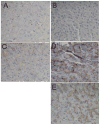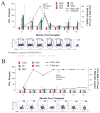Human liver transplantation as a model to study hepatitis C virus pathogenesis
- PMID: 19877210
- PMCID: PMC2954677
- DOI: 10.1002/lt.21866
Human liver transplantation as a model to study hepatitis C virus pathogenesis
Abstract
Hepatitis C is a leading etiology of liver cancer and a leading reason for liver transplantation. Although new therapies have improved the rates of sustained response, a large proportion of patients (approximately 50%) fail to respond to antiviral treatment, thus remaining at risk for disease progression. Although chimpanzees have been used to study hepatitis C virus biology and treatments, their cost is quite high, and their use is strictly regulated; indeed, the National Institutes of Health no longer supports the breeding of chimpanzees for study. The development of hepatitis C virus therapies has been hindered by the relative paucity of small animal models for studying hepatitis C virus pathogenesis. This review presents the strengths of human liver transplantation and highlights the advances derived from this model, including insights into viral kinetics and quasispecies, viral receptor binding and entry, and innate and adaptive immunity. Moreover, consideration is given to current and emerging antiviral therapeutic approaches based on translational research results.
Figures








Similar articles
-
Neutralizing antibodies and pathogenesis of hepatitis C virus infection.Viruses. 2012 Oct 9;4(10):2016-30. doi: 10.3390/v4102016. Viruses. 2012. PMID: 23202451 Free PMC article. Review.
-
Infectious diseases. Hard-won advances spark excitement about hepatitis C.Science. 2001 Oct 19;294(5542):506-7. doi: 10.1126/science.294.5542.506. Science. 2001. PMID: 11641482 No abstract available.
-
Influence of occult hepatitis B virus infection in chronic hepatitis C outcomes.World J Gastroenterol. 2011 Mar 28;17(12):1558-62. doi: 10.3748/wjg.v17.i12.1558. World J Gastroenterol. 2011. PMID: 21472121 Free PMC article. Review.
-
Current and future hepatitis C therapies.Arch Med Res. 2007 Aug;38(6):678-90. doi: 10.1016/j.arcmed.2006.09.002. Arch Med Res. 2007. PMID: 17613359 Review.
-
Natural killer cells in hepatitis C: Current progress.World J Gastroenterol. 2016 Jan 28;22(4):1449-60. doi: 10.3748/wjg.v22.i4.1449. World J Gastroenterol. 2016. PMID: 26819513 Free PMC article. Review.
Cited by
-
Deep sequencing analysis of HCV NS3 resistance-associated variants and mutation linkage in liver transplant recipients.PLoS One. 2013 Jul 29;8(7):e69698. doi: 10.1371/journal.pone.0069698. Print 2013. PLoS One. 2013. PMID: 23922778 Free PMC article.
-
Opposite Effects of Two Human ATG10 Isoforms on Replication of a HCV Sub-genomic Replicon Are Mediated via Regulating Autophagy Flux in Zebrafish.Front Cell Infect Microbiol. 2018 Apr 4;8:109. doi: 10.3389/fcimb.2018.00109. eCollection 2018. Front Cell Infect Microbiol. 2018. PMID: 29670865 Free PMC article.
-
Rate of hepatitis C viral clearance by human livers in human patients: Liver transplantation modeling primary infection and implications for studying entry inhibition.PLoS One. 2017 Jul 21;12(7):e0180719. doi: 10.1371/journal.pone.0180719. eCollection 2017. PLoS One. 2017. PMID: 28732019 Free PMC article.
References
-
- Gane EJ. The natural history of recurrent hepatitis C and what influences this. Liver Transpl. 2008;14 (Suppl 2):S36–44. - PubMed
-
- Gordon FD, Kwo P, Vargas HE. Treatment of hepatitis C in liver transplant recipients. Liver Transpl. 2009;15(2):126–35. - PubMed
-
- Terrault NA. Hepatitis C therapy before and after liver transplantation. Liver Transpl. 2008;14 (Suppl 2):S58–66. - PubMed
-
- Cohen J. Animal studies. NIH to end chimp breeding for research. Science. 2007;316(5829):1265. - PubMed
-
- Mercer DF, Schiller DE, Elliott JF, et al. Hepatitis C virus replication in mice with chimeric human livers. Nat Med. 2001;7(8):927–33. - PubMed
Publication types
MeSH terms
Substances
Grants and funding
LinkOut - more resources
Full Text Sources
Medical
